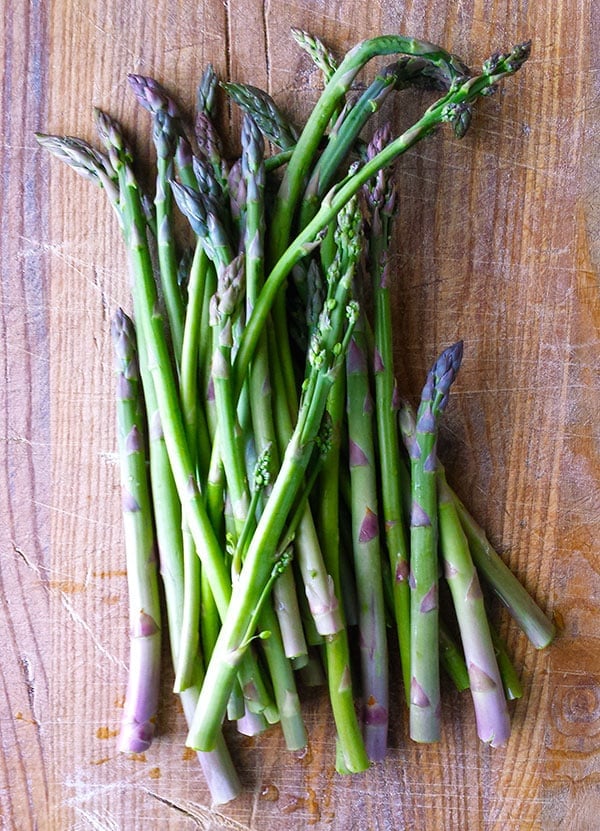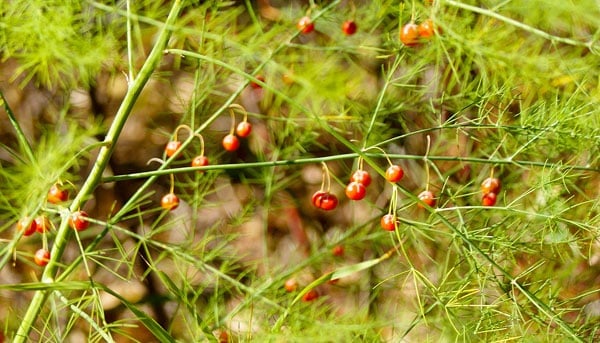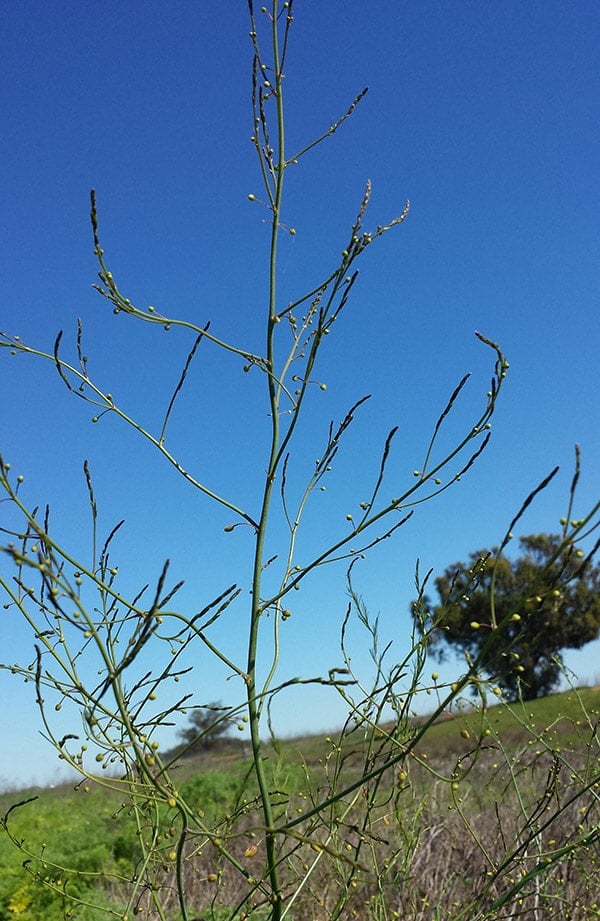As an Amazon Associate I earn from qualifying purchases.

To stalk the wild asparagus is to touch the shadow of our greatest modern forager, the late Euell Gibbons, whose book of that name was not only the first foraging book I read as a child, but was also the first foraging book for nearly every forager over the age of 35. We all read it read greedily, over and over until in many cases our copy collapsed from wear.
Despite this, instructions on actually finding wild asparagus are impossibly rare in foraging literature. Perhaps some writers view the feral sprout as beneath them — it is not a native to North America, after all. Maybe some think it too easy to find, or, so precious they dare not reveal the secret.
I aim to change that.
Asparagus officinalis, you should know, is precisely the same plant you buy in the store. It is not, strictly speaking, wild. It is feral. Like fennel in California, it has escaped from cultivation in the 400 years since Europeans brought it to the New World.
Now asparagus lives in every state in the United States and every province in Canada, as well as through much of Mexico. So you’d think it would be all over the place, and indeed in a few places it is.
The reality is that asparagus is not everywhere. For example, it is found in fewer than half the counties of California, and is equally spotty in Oregon. Most states have asparagus zones, and asparagus-free zones.
Knowing which was which was once tricky, but thanks to the USDA, you can see in which counties asparagus grows on this map, which will zoom in down to the location level in some states.
That will get you close. But you still need to actually find the young, tender spears in early spring, when they emerge from a scraggly root crown that can live in excess of 50 years.
When in early spring? As early as February in California, as late as June in Canada. Every region has its indicator. Here it’s when the wild mustard blooms. In other places it’s when lilacs blossom.
When you are ready to start, look for saline or alkaline soil. The patch I pick, in the Suisun Marsh, is a brackish swamp. Moisture is important. Asparagus doesn’t want its feet wet, but wants to be close enough to get the benefit. This can be anywhere in the East and South, but in the arid West, you will need to focus on marsh edges, irrigation ditches and near cattle ponds or sloughs and streams.
Asparagus will only live in full sun, or close to it. You can find it near small trees and even in briar patches, but never in a forest or even an open wood. Here they like to hang out with hemlock, wild mustard, curly dock and tules (And ticks. Keep a watchful eye for the evil critters).
If you see salicornia (pickleweed, saltwort, etc), you are too salty. Step back a few feet. In the Midwest — southern Michigan is an exceptionally good place to look for wild asparagus, for example — look around ditches, hedgerows, farm field edges and especially fence lines.
OK, so you are in a likely spot. What to look for?
You’ll know an asparagus spear when you see it, so that’s not a problem. But finding them can be the devil. Your best bet is to look for old plants from the previous year. Asparagus is an herbaceous perennial, meaning the growth above ground dies back every year. As a flourishing plant, asparagus is tall, up to 6 feet tall, and ferny, like fennel or dill.
There are male and female plants, and the female plants will eventually sport pretty red berries all over the ferny foliage. Alas, the berries are toxic, so don’t eat them.

When the plant dies back in late fall, it turns a lovely canary yellow — a color most other dying plants don’t have, so this is a way to spot them in fall. If you do, mark the spot on a GPS or make a mental note so you can return in early spring. Winters in even mild areas like mine will often knock that old growth over, so you will need to look for what appears to be a dead ferny plant on the ground. It helps to know that the foliage all stems from the central stalk, which was the asparagus spear. If you are still unsure, look at the base of the dead plant: It should have scars identical to the triangular leaf scars on every asparagus stalk.
Once you find a plant, stop. Look. Let your eyes adjust. Finding asparagus spears can often be as hard as finding morels. But once you do spot them, you can go to town.

Use a knife to cut each spear at ground level. Generally speaking, a plant puts up a set of skinny spears first, then fat ones, then finishes with skinny ones. Many times the plant will send up a precocious spear so early that it has already begun to fern out by the time you are out looking. This is a boon to spotting the plant.
It’s a fact that a plant that is kept cut will send up more spears than one only harvested once. So you can come back to a patch a couple times. But be absolutely certain you leave several spears to grow fully, or you will weaken or even kill the plant. Asparagus can grow an inch a day in perfect conditions, so be vigilant. The season is an orgy of asparagi, not a marathon.
I don’t know about you, but I can eat a pound of asparagus at a sitting. Most people can’t. So the question of preserving asparagus becomes an issue. Now I know lots of people claim to like pickled asparagus, but I am not one of them. For me, I gorge and gorge on asparagus until it’s all gone. And then I move to the next awesome vegetable of spring.
But if you wanted to preserve wild asparagus, my advice is to blanch the spears in boiling, salty water for 3 minutes, shock them in a big bowl of ice water, then pat dry, vacuum seal and freeze. I’ve done this and the result is better than any other preservation method, but still can’t hold a candle to fresh-from-the-ground asparagus.
So go forth. Seek ye the glorious wild asparagus, harbinger of spring and mischievous agent of stinky pee. Eat, feast, gorge! Just don’t ask me where my spot is.




I have not yet found it here in Southern Maine, but we have fiddleheads! A possible column on those? Love your writing!
It would’ve been nice if there was pics to show what it looks like in spring, summer and fall.
When I used to live in Melbourne, (in Victoria, Australia) there were some good patches of feral asparagus growing on the banks of the Yarra River, from Dight’s Falls near the city out to Hay’s Paddock in the leafy suburb of Kew. Now that I live on the outskirts of a little bush town in the Barossa Valley of South Australia the plant is harder to find, since SA is overall much drier than Vic, but it still turns up in old gardens here, or as garden escapes. You can eat it raw, steamed or very lightly boiled or stirfried. I like it with butter and lemon juice, with a grind of black pepper or the ground seeds of Alexanders (Smyrnium olusatrum).
A good asparagus bed can easily last a century – I have been shown the vegetable gardens of a few old stately homes down on the Adelaide plains, including the gardens at Government House and Heywood House, and their asparagus beds just seem to get better with age!
So … Hank and old Euell Gibbons, eh. Anyone ever read Euell’s Hawaiian beachcoming/foraging journal?
I have recently returned to my roots here in the USA. I had been living in Greece for the past 26 years. I have foraged the wild asparagus all over the lands there and have instructed many others on how and where to find it. It does grow in the forests there, often amongst a rather prickly neighboring plant, under the pine trees. It is so incredibly delicious and not exactly like the cultivated cousin. I will miss it and the great times hunting for it!
Can I move the wild asparagus in my yard to another location? It’s growing in very sandy soil above Lake Michigan
So timely…this article I found. I’m crazy excited to find some asparagus growing here along our road. Three patches so far. It is August in S. E. Tennessee and I am wondering if I should go ahead and cut some of it back/harvest it or just leave it till springtime. My Mama used to grow it in her huge tractor tire garden in Athens…It is so very beautiful and fluffy, especially in the very early morning with the dew sparkling like diamonds!!! Ahhh. We are blessed indeed. Greetings to all you foragers out there.
Kimberly: Mark the spot and come back in spring. Or at least, that is what I would do.
you know Hank, this Asparagus page, paradoxically, is the best No CA growing guide (for home garden) on Asparagus I’ve found on the net.
its darn impossible to know/filter out what conditions they really like by looking at gardening websites. this is way better. you describe the origin, shape, dimensions, seeding, toxicity, growing conditions, light conditions perfectly!! thanks Hank!!!
I agree! A well written accurate article. I’ve been hunting asparagus for about 5 years and how Hank described the expedition here is all true.
I found some by the shed in my yard and by the fence line in my yard – Central Kentucky.
Can I cut down the big stock to make more shoots come up? How does it work – there are 3 or 4 big tree like shoots and maybe 3 little edible shoots next to it. I just want to know the best way to harvest it.
Kerry: Leave the big ones as they will make sure the plant itself doesn’t die. Just take the little stalks this year, and mark it for next year’s harvest.
I learned recently my father-in-law and his brothers would “hunt” asparagus along railroad tracks during the 1930s as a way to supplement the family’s food stores, and to sell surplus for cash. Other relatives say he described it as hard, boring work.
I really appreciate this article because you give a great sense of what he was looking for, where he was likely to find it, and maybe how he managed the feral patches he returned to each spring.
Thanks so much.
Along tracks is also a very good place to look for wild fennel.
People have told me that if you snap them off, rather than cut, the stalks will remain soft rather than becoming hard and stringy. What have you all found?
You are kind to share. As a novice forager it is the excitement of any first & repeated wild find while considering Nature & nurture. Thanks for such a helpful read & provided photos!
One way to learn to identify it is to buy seeds and grow it for entire season. It will not send up spears until the following spring. But you will be able to see it’s dill like appearance, it’s berries and see it’s change color. Take note of when these changes happen as well as when the spears appear in the spring. It will give you a rough idea when to expect these thing in your area. Flowering and sending up spears may vary due to weather but you will know what to look for.
Don’t rely too much on those maps. They may say that asparagus isn’t in a lot of counties but that’s just because nobody has reported it there. We’re in a rural county in Minnesota that supposedly has no asparagus, and we harvest about 65 pounds a year (and that’s competing with a lot of other area foragers who do fine too!). 🙂
Montana is the same. I forage asparagus (I’m a transplant originally from IL). There are counties not showing on the map that I frequent for my asparagus feasts
How do you know if it’s in your county or not? Where do you find the map that gives you that Information?
https://plants.usda.gov/core/profile?symbol=ASOF
….still need to know when, here in Southeastern Ct. Can’t seem to find any in my old haunts…and I have since moved again in Ct.
There are some that grow by the track at my high school.